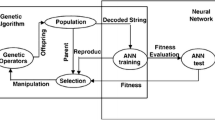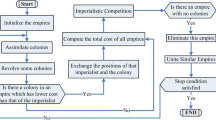Abstract
Air overpressure is one of the most undesirable destructive effects induced by blasting operation. Hence, a precise prediction of AOp has vital importance to minimize or reduce the environmental effects. This paper presents the development of two artificial intelligence techniques, namely artificial neural network (ANN) and ANN based on genetic algorithm (GA) for prediction of AOp. For this purpose, a database was compiled from 97 blasting events in a granite quarry in Penang, Malaysia. The values of maximum charge per delay and the distance from the blast-face were set as model inputs to predict AOp. To verify the quality and reliability of the ANN and GA-ANN models, several statistical functions, i.e., root means square error (RMSE), coefficient of determination (R 2) and variance account for (VAF) were calculated. Based on the obtained results, the GA-ANN model is found to be better than ANN model in estimating AOp induced by blasting. Considering only testing datasets, values of 0.965, 0.857, 0.77 and 0.82 for R 2, 96.380, 84.257, 70.07 and 78.06 for VAF, and 0.049, 0.117, 8.62 and 6.54 for RMSE were obtained for GA-ANN, ANN, USBM and MLR models, respectively, which prove superiority of the GA-ANN in AOp prediction. It can be concluded that GA-ANN model can perform better compared to other implemented models in predicting AOp.







Similar content being viewed by others
References
Khandelwal M, Singh TN (2007) Evaluation of blast-induced ground vibration predictors. Soil Dyn Earthq Eng 27:116–125
Dindarloo SR (2015) Prediction of blast-induced ground vibrations via genetic programming. Int J Min Sci Technol 25:1011–1015
Shirani Faradonbeh R, Jahed Armaghani D, Abd Majid MZ, Tahir MMD, Ramesh Murlidhar B, Monjezi M, Wong HM (2016) Prediction of ground vibration due to quarry blasting based on gene expression programming: a new model for peak particle velocity prediction. Int J Environ Sci Technol. doi:10.1007/s13762-016-0979-2
Singh PK, Sinha A (2013) Rock fragmentation by blasting, Fragblast 10. Taylor & Francis Group, London, p 427
Khandelwal M, Singh TN (2005) Prediction of blast induced air overpressure in opencast mine. Noise Vib Control Worldw 36:7–16
Khandelwal M, Kankar PK (2011) Prediction of blast-induced air overpressure using support vector machine. Arab J Geosci 4:427–433
Dindarloo SR (2015) Peak particle velocity prediction using support vector machines: a surface blasting case study. J South Afr Inst Min Metall 115:637–643
Amiri M, Bakhshandeh Amnieh H, Hasanipanah M, Mohammad Khanli L (2016) A new combination of artificial neural network and K-nearest neighbors models to predict blast-induced ground vibration and air-overpressure. Eng Comput. doi:10.1007/s00366-016-0442-5
Siskind DE, Stachura VJ, Stagg MS, Koop JW (1980) Structure response and damage produced by airblast from surface mining. Report of investigations, vol 8485. United States Bureau of Mines, Washington, DC
Hustrulid WA (1999) Blasting principles for open pit mining: general design concepts. Balkema, Amsterdam
Kuzu C, Fisne A, Ercelebi SG (2009) Operational and geological parameters in the assessing blast induced airblast-overpressure in quarries. Appl Acoust 70:404–411
Jahed Armaghani D, Hajihassani M, Sohaei H, Mohamad ET, Marto A, Motaghedi H, Moghaddam MR (2015) Neuro-fuzzy technique to predict air-overpressure induced by blasting. Arab J Geosci 8(12):10937–10950
Jahed Armaghani D, Hasanipanah M, Mohamad ET (2016) A combination of the ICA-ANN model to predict air-overpressure resulting from blasting. Eng Comput 32(1):155–171
Mohamad ET, Jahed Armaghani D, Hasanipanah M, Ramesh Murlidhar B, Asmawisham Alel MN (2016) Estimation of air-overpressure produced by blasting operation through a neuro-genetic technique. Environ Earth Sci 75:174. doi:10.1007/s12665-015-4983-5
Verma AK, Singh TN (2009) A Neuro-Genetic approach for prediction of compressional wave velocity of rock and its sensitivity analysis. Int J Earth Sci Eng 2(2):81–94
Verma AK, Singh TN, Monjezi M (2010) Intelligent prediction of heating value of coal. Iran J Earth Sci 2:32–38
Singh TN, Verma AK (2010) Sensitivity of total charge and maximum charge per delay on ground vibration. Geomat Nat Hazards Risk 1(3):259–272
Singh R, Vishal V, Singh TN (2012) Soft computing method for assessment of compressional wave velocity. Sci Iran 19(4):1018–1024
Verma AK, Singh TN (2012) Comparative analysis of intelligent algorithms to correlate strength and petrographic properties of some schistose rocks. Eng Comput 28:1–12
Singh R, Vishal V, Singh TN, Ranjith PG (2013) A comparative study of generalized regression neural network approach and adaptive neuro-fuzzy inference systems for prediction of unconfined compressive strength of rocks. Neural Comput Appl 23(2):499–506
Sawmliana C, Roy PP, Singh RK, Singh TN (2007) Blast induced air overpressure and its prediction using artificial neural network. Min Technol 116(2):41–48
Mohamed MT (2011) Performance of fuzzy logic and artificial neural network in prediction of ground and air vibrations. Int J Rock Mech Min Sci 48:845–851
Hasanipanah M, Jahed Armaghani D, Khamesi H, Bakhshandeh Amnieh H, Ghoraba S (2015) Several nonlinear models in estimating air-overpressure resulting from mine blasting. Eng Comput. doi:10.1007/s00366-015-0425-y
Jadav K, Panchal M (2012) Optimizing weights of artificial neural networks using genetic algorithms. Int J Adv Res Comput Sci Electron Eng 1:47–51
Momeni E, Nazir R, Jahed Armaghani D, Maizir H (2014) Prediction of pile bearing capacity using a hybrid genetic algorithm-based ANN. Measurement 57:122–131
Garrett J (1994) Where and why artificial neural networks are applicable in civil engineering. J Comput Civ Eng 8:129–130
Simpson P (1990) Artificial neural system: foundation, paradigms, applications and implementations. Pergamon, New York
Dreyfus G (2005) Neural networks: methodology and application. Springer, Berlin
Holland J (1975) Adaptation in natural and artificial systems. The University of Michigan Press, Ann Arbor
Chipperfield A, Fleming P, Pohlheim H (2006) Genetic algorithm toolbox for use with MATLAB User’s guide, version 1.2. University of Sheffield, Sheffield
Simpson AR, Dandy GC, Murphy LJ (1994) Genetic algorithms compared to other techniques for pipe optimization. J Water Res PL-ASCE 120:423–443
Lee Y, Oh S-H, Kim MW (1991) The effect of initial weights on premature saturation in back-propagation learning. In: Proceedings of the Seattle international joint conference on neural networks (IJCNN-91), vol 1. IEEE, pp 765–770
Majdi A, Beiki M (2010) Evolving neural network using a genetic algorithm for predicting the deformation modulus of rock masses. Int J Rock Mech Min Sci 47:246–253
TingXiang L, ShuWen Z, QuanYuan W et al. (2012) Research of agricultural land classification and evaluation based on genetic algorithm optimized neural network model. In: Wu Y (ed) Software engineering and knowledge engineering: theory and practice. Springer, Berlin, pp 465–471
Rashidian V, Hassanlourad M (2013) Predicting the shear behavior of cemented and uncemented carbonate sands using a genetic algorithm-based artificial neural network. Geotech Geol Eng 2:1–18
Chambers LD (2010) Practical handbook of genetic algorithms: complex coding systems. CRC Press, Boca Raton
Rajasekaran S, Vijayalakshmi Pai GA (2007) Neural networks, fuzzy logic, and genetic algorithms, synthesis and applications. Prentice-Hall of India, New Delhi
Hagan MT, Menhaj MB (1994) Training feed forward networks with the Marquardt algorithm. IEEE Trans Neural Networks 5:861–867
Saemi M, Ahmadi M, Varjani AY (2007) Design of neural networks using genetic algorithm for the permeability estimation of the reservoir. J Pet Sci Eng 59:97–105
Hopler RB (1998) Blasters’ handbook. International Society of Explosives Engineers, Cleveland, OH
Jahed Armaghani D, Hajihassani M, Monjezi M, Mohamad ET, Marto A, Moghaddam MR (2015) Application of two intelligent systems in predicting environmental impacts of quarry blasting. Arab J Geosci. doi:10.1007/s12517-015-1908-2
Khamesi H, Torabi S, Mirzaei-Nasirabad H, Ghadiri Z (2015) Improving the performance of intelligent back analysis for tunneling using optimized fuzzy systems: case study of the Karaj Subway Line 2 in Iran. J Comput Civ Eng 29(6):05014010
Swingler K (1996) Applying neural networks: a practical guide. Academic Press, New York
Looney CG (1996) Advances in feed-forward neural networks: demystifying knowledge acquiring black boxes. IEEE Trans Knowl Data Eng 8(2):211–226
Nelson M, Illingworth WT (1990) A practical guide to neural nets. Addison-Wesley, Reading MA
Hush DR (1989) Classification with neural networks: a performance analysis. In: Proceedings of the IEEE international conference on systems engineering, Dayton, pp 277–280
Maulenkamp F, Grima MA (1999) Application of neural networks for the prediction of the unconfined compressive strength (UCS) from Equotip hardness. Int J Rock Mech Min Sci 36:29–39
Hornik K, Stinchcombe M, White H (1989) Multilayer feedforward networks are universal approximators. Neural Netw 2:359–366
Sonmez H, Gokceoglu C, Nefeslioglu HA, Kayabasi A (2006) Estimation of rock modulus: for intact rocks with an artificial neural network and for rock masses with a new empirical equation. Int J Rock Mech Min Sci 43:224–235
Hecht-Nielsen R (1987) Kolmogorov’s mapping neural network existence theorem. In: Proceedings of the first IEEE international conference on neural networks, San Diego, pp 11–14
Ripley BD (1993) Statistical aspects of neural networks. In: Barndoff-Neilsen OE, Jensen JL, Kendall WS (eds) Networks and chaos-statistical and probabilistic aspects. Chapman & Hall, London, pp 40–123
Paola JD (1994) Neural network classification of multispectral imagery, M.Sc. thesis. The University of Arizona
Wang C (1994) A theory of generalization in learning machines with neural application, Ph.D. thesis. The University of Pennsylvania
Masters T (1994) Practical neural network recipes in C++. Academic Press, Boston
Kaastra I, Boyd M (1996) Designing a neural network for forecasting financial and economic time series. Neurocomputing 10:215–236
Kanellopoulas I, Wilkinson GG (1997) Strategies and best practice for neural network image classification. Int J Remote Sens 18:711–725
Rezaei M, Monjezi M, Yazdian Varjani A (2011) Development of a fuzzy model to predict flyrock in surface mining. Saf Sci 49:298–305
Tripathy A, Singh TN, Kundu J (2015) Prediction of abrasiveness index of some Indian rocks using soft computing methods. Measurement 68:302–309
SPSS Inc (2007) SPSS for Windows (version 16.0). SPSS Inc, Chicago
Author information
Authors and Affiliations
Corresponding author
Ethics declarations
Conflict of interest
The authors declare no conflict of interest.
Rights and permissions
About this article
Cite this article
Jahed Armaghani, D., Hasanipanah, M., Mahdiyar, A. et al. Airblast prediction through a hybrid genetic algorithm-ANN model. Neural Comput & Applic 29, 619–629 (2018). https://doi.org/10.1007/s00521-016-2598-8
Received:
Accepted:
Published:
Issue Date:
DOI: https://doi.org/10.1007/s00521-016-2598-8




